This guide is all you need to learn how to cook barley perfectly every time! Tender, chewy barley is a versatile whole grain that is nutritious, easy to cook, and can be used in many ways.

We’re diving a bit deeper into my Mediterranean pantry. Today’s ingredient spotlight is one of my personal favorite grains, barley!
Barley
Barley is a whole grain with a pleasant chewy texture and a slightly nutty flavor. It is also quite nutritious and rich in fiber, vitamins, and minerals, which is why it is a staple Mediterranean diet ingredient.
I love using barley in soups, salads, or as a base for delicious dinner bowls. I have used it as a stuffing for squash, Persian Soupe Jo (Chicken Barley Soup), and more. When I’m in the mood for something sweet, a bowl of warm barley with warmed milk and a good drizzle of Greek honey is my breakfast cereal.
Hulled vs. pearl barley
There are two main types of barley: hulled barley and pearled barley.
Hulled barley
Hulled barley is minimally processed where only the inedible outer hull is removed, while the grains still retain the bran and endosperm layer. It is more nutrient-dense, but hulled barley benefits from soaking in cold water for a few hours before cooking. Still it does take longer to cook (anywhere from 45 minutes to 1 hour).
Pearled barley
My kind of unfussy grain, pearl barley is a lighter cream-colored grain, and lacks the husk and bran layers. Pearl barley is still a nutritious, although it has less fiber and is not considered a “whole grain.” I mostly use the pearled version because it is easier to cook and is typically ready in less than 30 minutes (and no soaking required!)
Whichever type of barley you choose, it is easy to cook. All you need are a few cups of water or broth and simple seasonings (plain ol’ kosher salt works just fine!).

Is barley gluten free?
No, barley is not gluten-free, and should be avoided by those following a gluten-free diet. Brown rice is the most similar gluten-free grain substitute in recipes that call for barley. Quinoa would also work in a pinch.
Yield
To cook 1 cup of barley grains, you’ll need 3 cups of water or broth. Like many grains, barley swells considerably when cooked, so 1 cup of dry barley grains will yield 3 cups of tender cooked grains.
How to cook barley
Whether you are working with pearl barley as I am here or with hulled barley, the cooking method is very much the same, only one takes longer to cook. Here is how to make it:
- For hulled barley only, soak the dry grains. Put 1 cup of the dry hulled barley grains in a large bowl and add 3 cups of water. Leave it alone for a few hours or overnight. This is an optional step but does help the cooking water to penetrate the grains better. (Skip this step if using pearl barley).
- Cook the grains. Boil 3 cups of water (or broth) and add 1 cup of barley.Season to your liking. For me, a good pinch of kosher salt does the trick. Reduce the heat to medium-low and simmer, covered, until most (or all) of the liquid is absorbed and the barley is tender with a slightly chewy texture. Pearl barley takes 25 to 30 minutes to cook, and hulled barley will take 45 minutes to 1 hour to cook.
- Drain and garnish. Transfer the cooked barley to a colander to drain any excess liquid. Garnish with chopped parsley and serve.
How long will cooked barley last?
The beauty about this grain is that you can cook it ahead of time and keep it in the fridge to use on demand. You can also freeze it!
Once the barley comes to room temperature, store it in the fridge in an airtight container. It will keep in the fridge for about 3 to 4 days.
Or, transfer the cooled grains to a freezer-safe container and freeze it for up to 1 month.To reheat, defrost the barley in the refrigerator overnight. Then, add it to a saucepan on the stovetop with a few tablespoons of water. Cover and warm the barley over medium-high heat until heated through, tossing occasionally.
Ways to use barley
Its mild, slightly nutty flavor makes barley an incredibly versatile grain. You can use it in any number of ways, as it will not overpower other flavors.
Barley can take the place of almost any other grain in a recipe, but it is most similar to brown rice and farro in taste and texture.
Use it to add bulk to salads like this roasted cauliflower salad or soups including my turmeric lemon chicken soup (I intentionally don’t add noodles to this chicken soup so that I can use grains when I need to add volume).
I especially like using pearl barley as a bed for stews, making them even more comforting. A particular favorite of mine to pair with barley is this Mediterranean-style chicken stew – warming and hearty in the best way!
You can also use cooked barley to replace rice in simple dinner bowls like my Mediterranean tuna bowls or Lebanese chicken fatteh bowls.
And for something sweet, I love cooking pearl barley into a porridge and flavoring it up with some dried fruit, pungent spices, and a little brown sugar, like in this burbara recipe.
Really, the possibilities for this wholesome grain are endless. Use your imagination to create unexpected pairings!
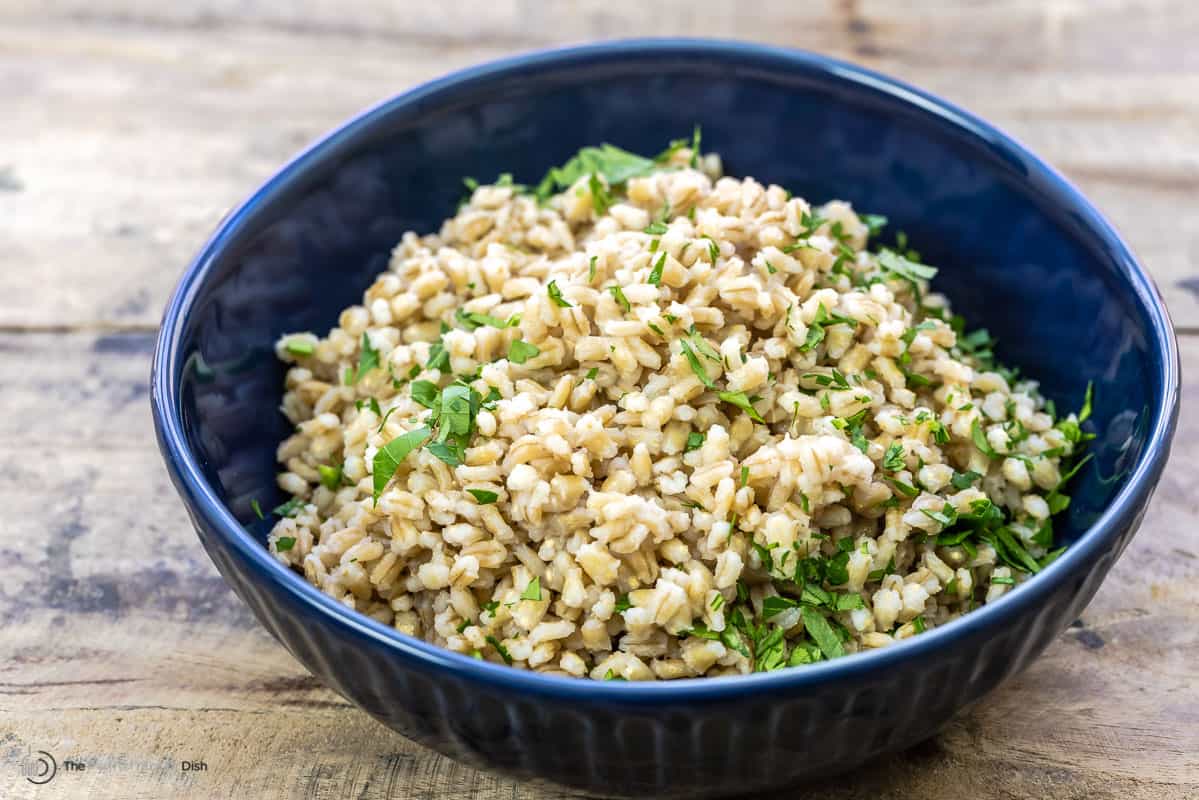
More FAQs
Barley has a similar nutrient profile to both white and brown rice. However, it has more fiber. If you are looking to increase your fiber intake, barley is the better option.
It is a very rich source of fiber, which both helps you stay full for longer, and improves digestion. It’s also rich in vitamins and minerals (such as copper, manganese, selenium, and vitamin B3).
Pearl barley does not need to be soaked prior to cooking because it cooks quickly. Hulled barley benefits from soaking in water for a few hours before cooking. However, you should still budget more time for the hulled grain to cook (about 35 to 40 minutes).
Barley recipes to try
Soups and Stews
Simple Mushroom Barley Soup
Mediterranean Diet Recipes
Mediterranean Roasted Vegetables Barley Recipe
Desserts
Burbara (Wheat Berry Pudding)
Featured from our shop: Pearl Barley. View all grains.
Browse more Mediterranean recipes
How to Cook Barley

Ingredients
- 1 cup barley, I used this pearl barley (hulled barley will also work in this recipe)
- 3 cups water (or broth)
- kosher salt
- Parsley, for garnish (optional)
Instructions
- If using pearled barely, you do not need to soak it (skip to the next step). If you are using hulled barley, you have the option to soak the grains in water for a while before cooking. To soak the hulled barley, place 1 cup dry barley grains in a large bowl and add 3 cups of water. Set aside to soak for a few hours or up to overnight.
- Boil 3 cups of water or broth and add 1 cup of barley. Season with a big dash of kosher salt.
- Cover and reduce the heat to medium-low. Simmer until the liquid is absorbed (or mostly absorbed) and the barley is tender with a slightly chewy texture (about 25 to 30 minutes for pearl barley and up to 1 hour for hulled barley). Drain.
- Fluff the cooked pearl barley with a fork. Add parsley for garnish, if using.
Video
Notes
- Dry vs. cooked barley conversion: 1 cup of dry barley will yield about 3 cups of cooked barley.
- Does barley need to be soaked? Pearl barley does not need to be soaked. Hulled barley can benefit from soaking for a few hours before cooking.
- How to store cooked barley: Store barley in the fridge in an airtight container. It will keep for about 3 days. You can also store it in a freezer-safe container and freeze it for up to 1 month. To reheat, defrost barley in the refrigerator overnight. Then, add the barley to a saucepan on the stove with a few tablespoons of water. Cover and warm over medium-high heat for a few minutes until heated through.
- Where to buy barley? Check out our barley and other grains via our online shop.
- Visit Our Shop for quality Mediterranean ingredients including extra virgin olive oils, spices, grains and more!
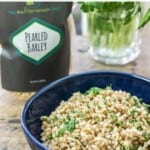
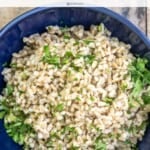

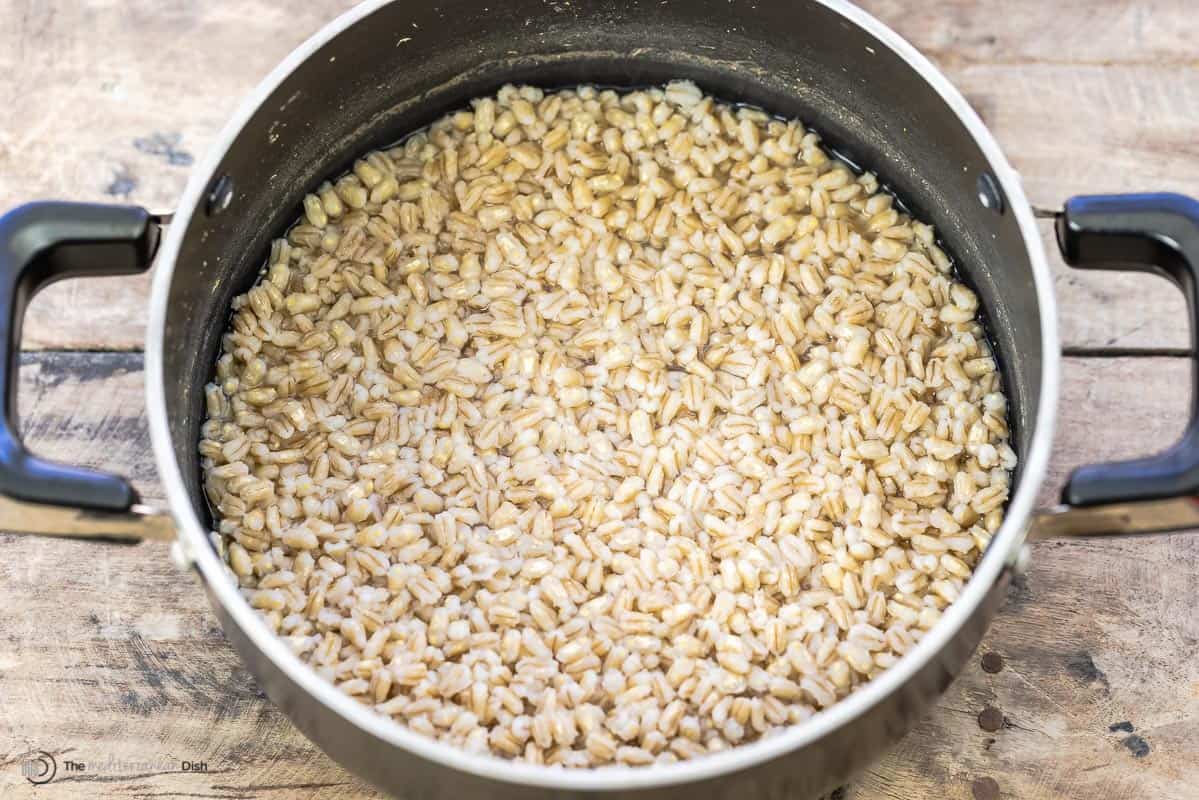

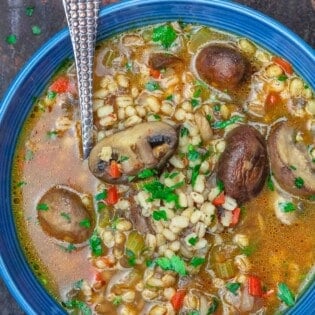

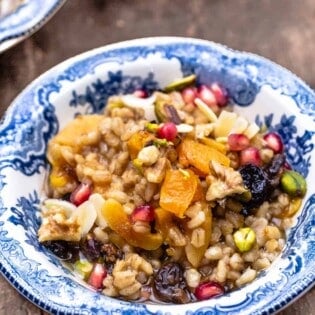

This recipe may work for pearled barley that is not soaked, but for the hulled barley that has been soaked overnight, this recipe calls for far too much water. I think I would use only 2 cups of water next time I try it.
Hi all looks delicious although I have not made your recipes yet. My neighbor gave me a bag of “pressed barley”. Do I use your recipe for pearl barley? First time, looking on line, I used a barley:water ratio of 1:3, but it was too soggy. My neighbor then told me she uses 1:1.5, and it was about right for the barley to come out like rice, which she wanted to eat in place of rice for better nutritional health. Thank you for your beautiful inspiring recipes